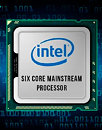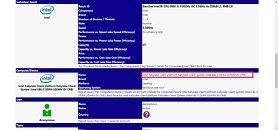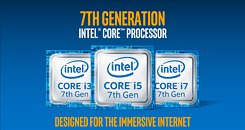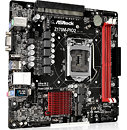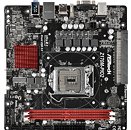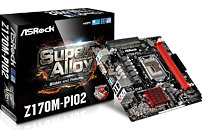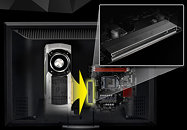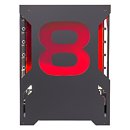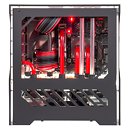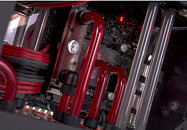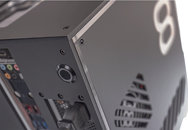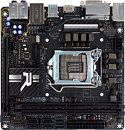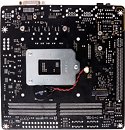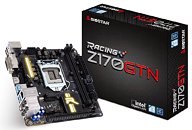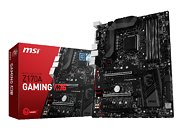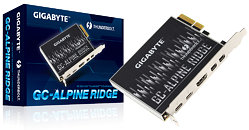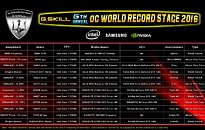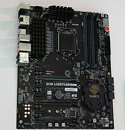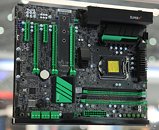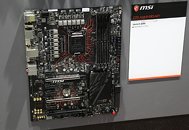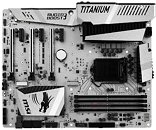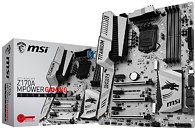Apr 10th, 2025 04:23 EDT
change timezone
Latest GPU Drivers
New Forum Posts
- [Update] FanControl (and other different monitoring software) blocked by Defender due to Winring0 vulnerability (2)
- Do you use Linux? (572)
- Help with updating firmware on a AOC Agon Pro OLED monitor, says I need Install Tool (3)
- HP EliteDesk 800 G2 SFF CPU support (2)
- Anyone know where to get driver updates / backdates for TUF A15? (4)
- EK Quantum Velocity intel to amd conversion (13)
- How is the Gainward Phoenix Model in terms of quality? (0)
- ## [Golden Sample] RTX 5080 – 3300 MHz @ 1.020 V (Stock Curve) – Ultra-Stable & Efficient (44)
- hp envy 15 rtx 2060 max-q stock vbios (1)
- (Some of) What I'd like to See From a Final Fantasy IX Remake (10)
Popular Reviews
- The Last Of Us Part 2 Performance Benchmark Review - 30 GPUs Compared
- ASRock Z890 Taichi OCF Review
- MCHOSE L7 Pro Review
- Sapphire Radeon RX 9070 XT Pulse Review
- PowerColor Radeon RX 9070 Hellhound Review
- Upcoming Hardware Launches 2025 (Updated Apr 2025)
- Sapphire Radeon RX 9070 XT Nitro+ Review - Beating NVIDIA
- Acer Predator GM9000 2 TB Review
- ASUS GeForce RTX 5080 Astral OC Review
- UPERFECT UStation Delta Max Review - Two Screens In One
Controversial News Posts
- NVIDIA GeForce RTX 5060 Ti 16 GB SKU Likely Launching at $499, According to Supply Chain Leak (174)
- MSI Doesn't Plan Radeon RX 9000 Series GPUs, Skips AMD RDNA 4 Generation Entirely (146)
- Microsoft Introduces Copilot for Gaming (124)
- AMD Radeon RX 9070 XT Reportedly Outperforms RTX 5080 Through Undervolting (119)
- NVIDIA Reportedly Prepares GeForce RTX 5060 and RTX 5060 Ti Unveil Tomorrow (115)
- Over 200,000 Sold Radeon RX 9070 and RX 9070 XT GPUs? AMD Says No Number was Given (100)
- Nintendo Switch 2 Launches June 5 at $449.99 with New Hardware and Games (99)
- Nintendo Confirms That Switch 2 Joy-Cons Will Not Utilize Hall Effect Stick Technology (99)
News Posts matching #Z170
Return to Keyword Browsing
Intel Launches B365 Express Chipset on 22nm Process, Possibly a Re-branded Z170
Intel today introduced the B365 Express desktop motherboard chipset as an in-between to its B360 Express and H370 Express chipsets. This model is part of Intel's optical enlargement of its motherboard chipsets to the 22 nm HKMG+ silicon fabrication node, to free up 14 nm++ for processors. Despite this, the TDP of the chipset remains unchanged at 6 Watts. The B365 has a couple of feature additions and subtractions over B360. To begin with it has a wider PCI-Express downstream root-complex, with 20 gen 3.0 lanes, on par with H370 Express. The B360, if you'll recall, only has 12 downstream PCIe lanes. This means B365 motherboards will have additional M.2 and U.2 connectivity.
According to the ARK specifications page for the B365 Express, this chip completely lacks integrated 10 Gbps USB 3.1 gen 2 connectivity. Perhaps the expanded downstream PCIe is really meant for motherboard vendors to use third-party USB 3.1 gen 2 controller chips. You still get eight 5 Gbps USB 3.0 ports (notice we didn't say USB 3.1 gen 1, because don't expect fast-charging features). The chipset also loses the latest generation Wireless AC integrated MAC. All of these point to the possibility of the B365 Express being a re-branded Z170 with locked CPU overclocking. Adding credence to this theory is the fact that while the B360 uses ME version 12, the B365 uses the older ME version 11. Much like the H310C, the B365 could include platform support for Windows 7.
According to the ARK specifications page for the B365 Express, this chip completely lacks integrated 10 Gbps USB 3.1 gen 2 connectivity. Perhaps the expanded downstream PCIe is really meant for motherboard vendors to use third-party USB 3.1 gen 2 controller chips. You still get eight 5 Gbps USB 3.0 ports (notice we didn't say USB 3.1 gen 1, because don't expect fast-charging features). The chipset also loses the latest generation Wireless AC integrated MAC. All of these point to the possibility of the B365 Express being a re-branded Z170 with locked CPU overclocking. Adding credence to this theory is the fact that while the B360 uses ME version 12, the B365 uses the older ME version 11. Much like the H310C, the B365 could include platform support for Windows 7.

Intel's Coffee Lake CPUs Likely Compatible With LGA 1151 Motherboards
Another interesting tidbit to have dropped from recent SiSotware leaks on Intel's upcoming Coffee Lake CPUs is that these could be backwards compatible with LGA 1151 motherboards that rock the 200 series chipset (and perhaps even the 100 series.) This last tidbit seems to be a bit of a stretch, even if it does end up being somewhat of a motherboard manufacturer's choice whether or not to issue updated, supporting BIOSes for the most recent Intel processors on their older boards. But why lose so many sales of motherboards equipped with Intel's upcoming, complimentary 300 series chipsets?
This piece of information comes courtesy of SiSoftware Sandra, again, where the 6-core Coffee Lake Intel chip, running @ 3.5 GHz, was tested in a Kaby Lake S platform - which features a 200 series chipset, no less. This means that there is a chance users will have a straight, drop-in upgrade path for Coffee Lake 6-core chips (seems Intel is no longer keeping all of those cores to themselves.) Doesn't that make the world seem a better place?
This piece of information comes courtesy of SiSoftware Sandra, again, where the 6-core Coffee Lake Intel chip, running @ 3.5 GHz, was tested in a Kaby Lake S platform - which features a 200 series chipset, no less. This means that there is a chance users will have a straight, drop-in upgrade path for Coffee Lake 6-core chips (seems Intel is no longer keeping all of those cores to themselves.) Doesn't that make the world seem a better place?

Shuttle XPCs Now Available with Kaby Lake Support
The new year now heralds the arrival of the 7th generation of the Intel Core processors at Shuttle. The first chips for the mobile segment appeared under the code name Kaby Lake back in the autumn of last year. The desktop version is now hitting the market in the first quarter of 2017. What Kaby Lake means for users is primarily more graphics performance coupled with lower power consumption. A BIOS update is required to make current Shuttle XPC Barebones compatible. An XPC with an LGA 1151 socket is also essential.
Eurocom Launches the 15.6" Tornado F5 - 4K, GTX 1080, i7 7700K, 64 GB DDR4 RAM
Eurocom launches the fully upgradeable, high performance 15.6" Tornado F5 with NVIDIA GeForce GTX 1080 graphics, Intel Core i7 7700K processor, 64 GB DDR4 memory via four slots, dual M.2 SSD slots and a 4K 15.6" display.
EUROCOM Tornado F5 users who own an Intel Core i7-6700K SKU can upgrade to the i7-7700K since the two processors share the same LGA 1151 socket. The EUROCOM Tornado F5 is one of the few laptops with a Z170 chipset, LGA 1151 CPU socket and MXM 3.0 graphics slot for a wide range of customization options. Two M.2 SSD PCIe x2/x4 or SATA SSD and one 9.5mm SATA3 6Gb/s storage drive is also supported to offer a great combination of capacity and speed. Four memory slots are available to support up to 64 GB of DDR4 SODIMM. Customers have a 15.6" FHD matte display and a 4K matte display to choose from as well.
EUROCOM Tornado F5 users who own an Intel Core i7-6700K SKU can upgrade to the i7-7700K since the two processors share the same LGA 1151 socket. The EUROCOM Tornado F5 is one of the few laptops with a Z170 chipset, LGA 1151 CPU socket and MXM 3.0 graphics slot for a wide range of customization options. Two M.2 SSD PCIe x2/x4 or SATA SSD and one 9.5mm SATA3 6Gb/s storage drive is also supported to offer a great combination of capacity and speed. Four memory slots are available to support up to 64 GB of DDR4 SODIMM. Customers have a 15.6" FHD matte display and a 4K matte display to choose from as well.

Intel Core i7-7700K Cracks 7 GHz Bench-Stable Overclock
It may have practically no IPC gains over its predecessor, but Intel's 7th generation Core "Kaby Lake" unlocked processors are shaping up to be an overclocker's delight. A Core i7-7700K sample tested by professional overclocker Allen "Splave" Golibersuch was able to breach the 7 GHz barrier. To achieve this feat however, HyperThreading was disabled, and two of the four CPU cores were also disabled.
Paired with an ASRock Z170 OC Formula motherboard, the i7-7700K was bench-stable at 7022.96 MHz, at the chip's maximum base clock multiplier of 69x, and a base-clock of 101.78 MHz. The Vcore voltage was set at a scorching 2.00V. The chip crunched PiFast in 9.02 seconds, SuperPi 32M in 4 minutes 20.25 seconds, wPrime 32M in 2.953 seconds, and wPrime 1024M in 1 minute 33.171 seconds. Paired with an ASUS GeForce GTX 1080 STRIX OC graphics card, it scored 643,316 points in Aquamark, and 86,798 points in 3DMark 05.
Paired with an ASRock Z170 OC Formula motherboard, the i7-7700K was bench-stable at 7022.96 MHz, at the chip's maximum base clock multiplier of 69x, and a base-clock of 101.78 MHz. The Vcore voltage was set at a scorching 2.00V. The chip crunched PiFast in 9.02 seconds, SuperPi 32M in 4 minutes 20.25 seconds, wPrime 32M in 2.953 seconds, and wPrime 1024M in 1 minute 33.171 seconds. Paired with an ASUS GeForce GTX 1080 STRIX OC graphics card, it scored 643,316 points in Aquamark, and 86,798 points in 3DMark 05.
Calyos Unveils the NGS Cube Passive-Cooled Gaming Desktop
Calyos, makers of compact workstations, unveiled the NGS Cube, a passively-cooled gaming desktop with performance-segment hardware. The star-attraction here is the case itself, which is made of aluminium, and encloses a network of heatsinks, heat pipes, and bases; and is capable of handling thermal loads of up to 200W. That gives it just enough muscle to cool the ZOTAC GeForce GTX 1060 Mini graphics card it includes (up to 120W TDP), and a quad-core CPU with TDP of up to 65W. Driving it all together is an ASUS Z170I Pro Gaming motherboard. The company is expected to showcase the NGS Cube at the 2017 International CES, with sales starting soon after.

Leaked Intel Core i7-7700K Sample Tested
The team over at Tom's Hardware have gotten their hands on Intel's new 'Kaby Lake' CPU - The Core i7-7700K. While the chip is not marked as an engineering sample, they cannot confirm with confidence that it is a retail part. They then did what we all hoped and expected, they put the new i7 through a series of benchmarks both at its stock speeds and overclocked. Without a retail Z270 series motherboard to test with, Kaby Lake compatible firmware was loaded onto their Gigabyte GA-Z170X-Ultra Gaming board.
In line with what has been reported so far, the stock clock speeds of their sample was 4.20GHz base and 4.50GHz max turbo boost with a TDP of 95W, up marginally from the i7-6700K's 91W. As tested the 7700K drew slightly more power under load than the 6700K whilst achieving benchmark results that are more-or-less in line with the percentage clock speed increase. Using the same core voltage for overclocking, the 7700K was able to manage a 4.8GHz overclock at 1.3v where the 6700K achieved 4.6GHz. As Intel did not change the core micro architecture between Skylake and Kaby Lake, it appears that save for HEVC and VP9 8/10-bit encode/decode and other possible features we may not yet know of, slightly faster clock speeds is the principal improvement. Given this is a pre-release test conducted on a motherboard that may not be able to unleash the full potential of the i7-7700K, the results should be taken with their appropriate pinch of salt. For the article and detailed findings, please follow the source link.
In line with what has been reported so far, the stock clock speeds of their sample was 4.20GHz base and 4.50GHz max turbo boost with a TDP of 95W, up marginally from the i7-6700K's 91W. As tested the 7700K drew slightly more power under load than the 6700K whilst achieving benchmark results that are more-or-less in line with the percentage clock speed increase. Using the same core voltage for overclocking, the 7700K was able to manage a 4.8GHz overclock at 1.3v where the 6700K achieved 4.6GHz. As Intel did not change the core micro architecture between Skylake and Kaby Lake, it appears that save for HEVC and VP9 8/10-bit encode/decode and other possible features we may not yet know of, slightly faster clock speeds is the principal improvement. Given this is a pre-release test conducted on a motherboard that may not be able to unleash the full potential of the i7-7700K, the results should be taken with their appropriate pinch of salt. For the article and detailed findings, please follow the source link.

MSI Gives Away "Mafia III" with Gaming Series Motherboards and Desktops
The two prestigious families of MSI and 2K GAMES have joined forces to present you a bundle you can't refuse. By purchasing any of the eligible MSI Intel GAMING X99/Z170/H179/B150 Motherboards or Windows 10 GAMING Desktops, you will get the MAFIA III game for free! Six years in the making, MAFIA III is the latest masterpiece by 2K GAMES and Hangar 13. Presenting a vast Open-World gaming experience with the legendary cinematic narrative the MAFIA series are known for. Featuring incredibly vivid facial animations and tense action, MAFIA III pledges to provide the most engaging gaming experience yet.
Fierce gunfights, close quarters combat and nail-biting car chases form some of the most thrilling chapters of this action masterpiece. MSI GAMING Motherboards & Desktops will keep you at the edge of your seat with Audio Boost 3 providing supreme audio components to support 8-channel HD audio output. While Military-class audio enhancer NAHIMIC will fully immerse you into the heart of the action with a full 3D surround experience. Gamers will feel the explosions, the gunshots and the screams of enemies biting the dust like they are there in person.
Fierce gunfights, close quarters combat and nail-biting car chases form some of the most thrilling chapters of this action masterpiece. MSI GAMING Motherboards & Desktops will keep you at the edge of your seat with Audio Boost 3 providing supreme audio components to support 8-channel HD audio output. While Military-class audio enhancer NAHIMIC will fully immerse you into the heart of the action with a full 3D surround experience. Gamers will feel the explosions, the gunshots and the screams of enemies biting the dust like they are there in person.

ASRock Unveils BIOS Updates for Next-Gen CPU Support to its LGA1151 Motherboards
ASRock's 100-series motherboards support Next Generation socket 1151 Intel Core Processors. Via a new BIOS update, ASRock Z170, H170, B150 and H110 series motherboards are resurrected. With only a few clicks, users are able to update the BIOS and enjoy the outstanding performance of next generation Intel processors.
Not only to those high-end and mainstream motherboards, ASRock also takes the latest BIOS to those entry level ones. From the Z170, H170, B150 series to the H110 series, users may expect more powerful processing speed yet enhanced capabilities by Intel's new processors. To download the latest BIOS updates, visit the ASRock website.
Not only to those high-end and mainstream motherboards, ASRock also takes the latest BIOS to those entry level ones. From the Z170, H170, B150 series to the H110 series, users may expect more powerful processing speed yet enhanced capabilities by Intel's new processors. To download the latest BIOS updates, visit the ASRock website.

ASUS Rolls Out BIOS Updates for Next-Generation LGA1151 Processors
ASUS today announced that all 100-series motherboards will now support next-generation Intel Core processors. A quick and easy UEFI BIOS update unleashes the full potential of the next-generation high-performance CPUs for socket LGA 1151, reaffirming ASUS as the BEST leading motherboard brand - Best Selling, Easy to Use, Stable and Trusted. Owners of ASUS Republic of Gamers (ROG), Pro Gaming, Signature and TUF Z170, H170, B150 and H110 motherboards are able to take advantage of the easy upgrade to the award-winning ASUS UEFI BIOS, which is available today via the relevant ASUS Support web page.
All ASUS 100-series motherboards that include the ASUS USB BIOS Flashback feature allow users to apply UEFI BIOS updates with ease. For other ASUS 100-series motherboards the necessary UEFI BIOS update takes just one click in an easy-to-use Windows-based BIOS updater application, ASUS EZ Update, which is available to download from the ASUS website.
All ASUS 100-series motherboards that include the ASUS USB BIOS Flashback feature allow users to apply UEFI BIOS updates with ease. For other ASUS 100-series motherboards the necessary UEFI BIOS update takes just one click in an easy-to-use Windows-based BIOS updater application, ASUS EZ Update, which is available to download from the ASUS website.

ASRock Unveils the Z170M-PIO2 Motherboard with Parallel Expansion Slot
ASRock unveiled the Z170M-PIO2, a micro-ATX socket LGA1151 motherboard with a unique angled PCI-Express gen 3.0 x16 slot that lets you install a graphics card parallel to the plane of the motherboard. It takes away the need for PCIe riser cables in certain PIO form-factor compliant SFF chassis. The PIO form-factor is an emerging standard of compact SFF cases that you mount along the VESA wall-mount bolts of your display. Technically, the board conforms to the uDTX form-factor, but is compatible with micro-ATX and PIO form-factors.
Its star-attraction aside, the Z170-PIO2, as its name suggests, is based on the overclocking-ready Z170 Express chipset. It supports up to 32 GB of dual-channel DDR4 memory with its two memory slots. The board draws power from a combination of 24-pin ATX and 4-pin CPU power connectors. Besides the angled PCIe x16, you get an mPCIe slot (for WLAN cards), and one 32 Gb/s M.2 slot. Four SATA 6 Gb/s ports, 6-channel HD audio, four USB 3.0 ports, and gigabit Ethernet make for the rest of its connectivity.
Its star-attraction aside, the Z170-PIO2, as its name suggests, is based on the overclocking-ready Z170 Express chipset. It supports up to 32 GB of dual-channel DDR4 memory with its two memory slots. The board draws power from a combination of 24-pin ATX and 4-pin CPU power connectors. Besides the angled PCIe x16, you get an mPCIe slot (for WLAN cards), and one 32 Gb/s M.2 slot. Four SATA 6 Gb/s ports, 6-channel HD audio, four USB 3.0 ports, and gigabit Ethernet make for the rest of its connectivity.

MSI Announces BIOS Updates for Next-Generation LGA1151 Processors
MSI, world leading and most popular gaming component brand, is pleased to announce that all current MSI 100 series chipset motherboards fully support the next generation LGA 1151 socket processors. The BIOS updates are now made available for download via the official MSI website. With these BIOS updates users can benefit from better performance and compatibility using the latest Intel processors with better specification and higher frequencies. Highly acclaimed, MSI continues to push for outstanding performance, a unique and attractive look & feel and solid reliability for its 100 series motherboards.
8Pack Announces the Rocket Compact LAN PC
Aesthetically unparalleled. Uncompromised in performance. Most popularly known for pushing PCs past their limits and holding multiple records at the world's largest overclocking events, Ian "8Pack" Parry is no stranger when it comes to breaking the laws of what many PC enthusiasts would commonly consider to be the impossible.
Meet the 8Pack Rocket. Distinctly crafted, highly refined and equipped with nothing less than the best, 8Pack's latest beast isn't one that's happy being confined to the home. Designed for portability and travel, all-the-while packing the power; the 8Pack Rocket is an overclocked powerhouse for on-the-go performance that's perfect for LAN parties.
Meet the 8Pack Rocket. Distinctly crafted, highly refined and equipped with nothing less than the best, 8Pack's latest beast isn't one that's happy being confined to the home. Designed for portability and travel, all-the-while packing the power; the 8Pack Rocket is an overclocked powerhouse for on-the-go performance that's perfect for LAN parties.

BIOSTAR Announces the Racing Z170GTN Flagship Mini-ITX Motherboard
BIOSTAR is pleased to announce its latest and greatest motherboard to join the prestigious RACING series motherboard family with the unveiling of the BIOSTAR Z170GTN mini-ITX motherboard. Everything that makes the RACING series motherboards from BIOSTAR now comes in a tiny form factor giving you all the power you need without compromising size and space. Gamers who want unrestricted performance but want a compact machine for their entertainment and gaming needs, the BIOSTAR RACING Z170GTN delivers everything you need.
The BIOSTAR RACING Z170GTN allows full control of your system with support for unlocked 6th-generation Intel Core processors allowing you to fully maximize the capability of your system and increase performance. Support for memory speeds up to DDR4-3200 allows high-speed memory to compliment the overclocked system for improved responsiveness. The Intel Z170 chipset allows a full array of connectivity including rich USB3.0 connection and high-speed storage via built-in U.2 connector with up to 32Gbps bandwidth for next-generation storage allowing users to utilize the fastest storage platforms of today for super-fast access to data so games load faster so you can get to the action quicker.
The BIOSTAR RACING Z170GTN allows full control of your system with support for unlocked 6th-generation Intel Core processors allowing you to fully maximize the capability of your system and increase performance. Support for memory speeds up to DDR4-3200 allows high-speed memory to compliment the overclocked system for improved responsiveness. The Intel Z170 chipset allows a full array of connectivity including rich USB3.0 connection and high-speed storage via built-in U.2 connector with up to 32Gbps bandwidth for next-generation storage allowing users to utilize the fastest storage platforms of today for super-fast access to data so games load faster so you can get to the action quicker.

MSI Announces the Z170A Gaming M6 Motherboard
MSI is proud to announce the new Z170A GAMING M6 motherboard for the enthusiast gamers. Premiering two significant new features, Lightning USB and the next generation Killer networking technology, the Z170A GAMING M6 adopts evil gray as its major color scheme, bringing a whole new look and feel to the game table. This motherboard also offers Twin Turbo onboard M.2, Audio Boost 3 and a plethora of other game enhancing features.
The traditional ASMedia 1142 USB 3.1 controller chip on current motherboards is connected via either PCIe Gen2 x2 (10Gb/s) or Gen3 x1 (8Gb/s) which limits the USB 3.1 Gen2 transfer rates (10Gb/s). MSI is now proud to introduce the first ever motherboard to have the next generation Lighting Asmedia 2142 USB 3.1 Gen2 controller chip which runs at PCIe Gen3 x2 (16Gb/s) which is twice as fast. In combination with MSI's exclusive USB Speed Up there is no faster USB 3.1 Gen2 solution on the market. The PCIe Gen3 connection will also help to boost transfer speeds enormously when using two USB 3.1 Gen2 devices at the same time. The MSI Z170A GAMING M6 comes with both an USB 3.1 Gen 2 Type-A and Type-C interface.
The traditional ASMedia 1142 USB 3.1 controller chip on current motherboards is connected via either PCIe Gen2 x2 (10Gb/s) or Gen3 x1 (8Gb/s) which limits the USB 3.1 Gen2 transfer rates (10Gb/s). MSI is now proud to introduce the first ever motherboard to have the next generation Lighting Asmedia 2142 USB 3.1 Gen2 controller chip which runs at PCIe Gen3 x2 (16Gb/s) which is twice as fast. In combination with MSI's exclusive USB Speed Up there is no faster USB 3.1 Gen2 solution on the market. The PCIe Gen3 connection will also help to boost transfer speeds enormously when using two USB 3.1 Gen2 devices at the same time. The MSI Z170A GAMING M6 comes with both an USB 3.1 Gen 2 Type-A and Type-C interface.

GIGABYTE Offers Another Free Thunderbolt 3 Upgrade
GIGABYTE TECHNOLOGY Co. Ltd., a leading manufacturer of motherboards and graphics cards is proud to announce today, a new collection of GIGABYTE Motherboards that have been certified for Intel's Thunderbolt 3 technology. GIGABYTE is the leader in developing this technology as many devices in the market were created using GIGABYTE Motherboards as the golden sample.
Shortly after its release of the new Designare and ultra gaming motherboards GIGABYTE is announcing that many of these newly released boards have Thunderbolt 3 technology available to the users. Updating the BIOS and a simple software upgrade is all that is required of users to enable this feature. With a 40 Gb/s bandwidth, along with its ability to transmit data, video, audio, and power all in one cable, Thunderbolt technology is highly sought after for its rapid transfer speeds and ability to simplify cables around the computer. Users are able to daisy-chain up to six devices per port with an additional monitor at the end.
Shortly after its release of the new Designare and ultra gaming motherboards GIGABYTE is announcing that many of these newly released boards have Thunderbolt 3 technology available to the users. Updating the BIOS and a simple software upgrade is all that is required of users to enable this feature. With a 40 Gb/s bandwidth, along with its ability to transmit data, video, audio, and power all in one cable, Thunderbolt technology is highly sought after for its rapid transfer speeds and ability to simplify cables around the computer. Users are able to daisy-chain up to six devices per port with an additional monitor at the end.

Colorful Announces the iGame Z170 YMIR-G Motherboard
Colorful Technology Company Limited, professional manufacturer of graphics cards and motherboards, proudly announces its feature-packed gaming motherboard: the iGame Z170 Ymir-G for the latest 6th-generation Intel Core processors. The latest part of the iGame family of high-performance products intended for gamers and enthusiasts, the iGAME Z170 Ymir-G motherboard boasts features for any and all kinds of gamers from modders to streamers.
The COLORFUL iGAME Z170 Ymir-G motherboard loads everything a gamer needs and more into a single motherboard. Supporting 6th-generation Intel processors for the LGA1151 socket, this motherboard supports processors up to 125w and delivers solid power to the CPU thanks to its 14-phase power delivery design which also helps in stable overclocking. The motherboard features rich connectivity options including a wide range of internal expansion and external I/O: high-speed storage via 32 Gb/s M.2 port, 16 Gb/s SATA Express ports, 10 Gb/s USB3.1 as well as USB Type-C, quick charge USB ports and dual-LAN support with both Intel i211 and Killer E2201 chips onboard.
The COLORFUL iGAME Z170 Ymir-G motherboard loads everything a gamer needs and more into a single motherboard. Supporting 6th-generation Intel processors for the LGA1151 socket, this motherboard supports processors up to 125w and delivers solid power to the CPU thanks to its 14-phase power delivery design which also helps in stable overclocking. The motherboard features rich connectivity options including a wide range of internal expansion and external I/O: high-speed storage via 32 Gb/s M.2 port, 16 Gb/s SATA Express ports, 10 Gb/s USB3.1 as well as USB Type-C, quick charge USB ports and dual-LAN support with both Intel i211 and Killer E2201 chips onboard.

GIGABYTE Announces X99 and Z170 Limited Edition Motherboards
GIGABYTE TECHNOLOGY Co. Ltd., a leading manufacturer of motherboards and graphics cards is proud to announce today, a promotion with EK Water Blocks, the world's top liquid cooling manufacture. This promotion will begin on August 1st, 2016 and will be held throughout Europe. GIGABYTE and EK Water Blocks promotion bundle includes an award winning GIGABYTE motherboard, GIGABYTE's X99-Ultra Gaming or Z170X-Gaming 7, paired with a limited edition nickel monoblock engraved with a custom G1 design or limited edition EK-Supremacy EVO X99 water block.
GIGABYTE and EK Water Blocks worked together in designing and engineering the EK-FB GA-Z170X Monoblock for the Z170X-GAMING 7-EK motherboard. This monoblock uses the award winning EK-Supremacy EVO cooling engine to ensure the best possible performance in CPU cooling. Not only does the monoblock help keep the CPU cool, but it also covers the power regulation (MOSFET) module allowing water to flow directly over all critical areas of the motherboard ensuring the highest possible overclocks.
GIGABYTE and EK Water Blocks worked together in designing and engineering the EK-FB GA-Z170X Monoblock for the Z170X-GAMING 7-EK motherboard. This monoblock uses the award winning EK-Supremacy EVO cooling engine to ensure the best possible performance in CPU cooling. Not only does the monoblock help keep the CPU cool, but it also covers the power regulation (MOSFET) module allowing water to flow directly over all critical areas of the motherboard ensuring the highest possible overclocks.

G.SKILL Achieves DDR4 5189.2MHz and 12 Overclocking Records in 8 Benchmarks
G.SKILL International Enterprise Co., Ltd., the world's leading manufacturer of extreme performance memory and gaming peripherals, is proud to announce that 12 overclocking records in 8 different benchmarks were broken during Computex week this year, including the world's fastest memory frequency world record at DDR4 5189.2 MHz.
Special thanks to the event sponsors Samsung, Intel, and NVIDIA, as well as the industry's leading performance motherboard vendors, including MSI, ASUS, EVGA, GIGABYTE, and ASRock, the G.SKILL 5th Annual OC World Record Stage brought together the world's most powerful PC hardware in one venue to demonstrate the bleeding edge limits of current technology. Over the course of the 5 days at Computex, multiple benchmarks records were pushed to the new extreme levels, using G.SKILL DDR4 memory built with Samsung ICs, Intel Core i7 processors, the latest NVIDIA GPU, and the newest Z170/X99 motherboards designed for extreme performance.
Special thanks to the event sponsors Samsung, Intel, and NVIDIA, as well as the industry's leading performance motherboard vendors, including MSI, ASUS, EVGA, GIGABYTE, and ASRock, the G.SKILL 5th Annual OC World Record Stage brought together the world's most powerful PC hardware in one venue to demonstrate the bleeding edge limits of current technology. Over the course of the 5 days at Computex, multiple benchmarks records were pushed to the new extreme levels, using G.SKILL DDR4 memory built with Samsung ICs, Intel Core i7 processors, the latest NVIDIA GPU, and the newest Z170/X99 motherboards designed for extreme performance.

ECS Unveils the Z170-Lightsaber
ECS Elitegroup showed off its latest flagship socket LGA1151 board, the Z170-Lightsaber, likely designed for its RGB LED product styling. The board features a 14-phase VRM powering the CPU, and expansion slots that include two PCI-Express 3.0 x16 (x8/x8 when both are populated), a third x16 (electrical x4) slot wired to the PCH, and four other x1 slots. Storage connectivity includes a 32 Gb/s M.2 with NVMe boot support, 16 Gb/s SATA-Express, and six SATA 6 Gb/s ports.
The modern connectivity on offer include two USB 3.1 ports (apparently both of them are type-A), six other USB 3.0 ports, DisplayPort 1.2 and HDMI 1.4, a gigabit Ethernet interface driven by Killer E2400 controller, and an audio solution with a 115 dBA SNR CODEC, ground-layer isolation, electrolytic capacitors, and a user-replaceable OPAMP. Overclocker friendly features include dual-BIOS with an on-demand BIOS backup/restore button, three performance preset buttons, power/reboot buttons, and a 3-digit POST error readout.
The modern connectivity on offer include two USB 3.1 ports (apparently both of them are type-A), six other USB 3.0 ports, DisplayPort 1.2 and HDMI 1.4, a gigabit Ethernet interface driven by Killer E2400 controller, and an audio solution with a 115 dBA SNR CODEC, ground-layer isolation, electrolytic capacitors, and a user-replaceable OPAMP. Overclocker friendly features include dual-BIOS with an on-demand BIOS backup/restore button, three performance preset buttons, power/reboot buttons, and a 3-digit POST error readout.
Supermicro Unveils First LGA1151 Motherboard with PCIe Bridge Chip
Supermicro launched the first socket LGA1151 motherboard featuring a PCIe bridge chip that expands the board's lane budget, something that not even the $600 ASUS Maximus VIII Extreme features. The new CZ170-OCE from the traditionally server/workstation motherboard maker is based on Intel Z170 Express chipset, and features a PCI-Express gen 3.0 x48 bridge chip (likely the PLX PEX-8747), which takes the PCI-Express 3.0 x16 PEG port from the CPU, and puts out 32 lanes, which are wired to the board's three PCIe 3.0 x16 slots.
The topmost slot runs at x16 full-time, while the middle and bottom slots are x8/x8 when both are populated (x16/NC/x16 or x16/x8/x8). The designers lavishly spent its remaining lane budget on two PCI-Express 3.0 x4 slots, and a 32 Gb/s M.2-22110 slot. Besides the 32 Gb/s M.2 slot, storage connectivity includes six SATA 6 Gb/s ports. Other modern connectivity includes two USB 3.1 ports (one each of type-A and type-C), two gigabit Ethernet connections (one driven by Intel I219V and another by Intel I210-AT), HD audio, and four other USB 3.0 ports.
The topmost slot runs at x16 full-time, while the middle and bottom slots are x8/x8 when both are populated (x16/NC/x16 or x16/x8/x8). The designers lavishly spent its remaining lane budget on two PCI-Express 3.0 x4 slots, and a 32 Gb/s M.2-22110 slot. Besides the 32 Gb/s M.2 slot, storage connectivity includes six SATA 6 Gb/s ports. Other modern connectivity includes two USB 3.1 ports (one each of type-A and type-C), two gigabit Ethernet connections (one driven by Intel I219V and another by Intel I210-AT), HD audio, and four other USB 3.0 ports.

MSI Teases its First Intel 200-series Chipset Motherboard
This could very well be the first picture of a socket LGA1151 motherboard based on Intel's upcoming 200-series chipset, which succeeds the 100-series. Named the Z2T0-Anniversary (is that a typo for Z270-Anniversary?), the board is likely based on the chipset that succeeds the Z170-Express (Z270-Express?), and will be timed with Intel's launch of the 7th generation Core "Kaby Lake" processors. MSI did not finalize the board's aesthetics (heatsink design, PCB markings), but the development board seems pretty loaded with features, that rival the current Z170A-Gaming M7 (we know this from the 6-layer PCB markings). MSI says that the board will be launched in November, 2016.

GIGABYTE Also Unveils H170-Designare
In addition to the Z170-Designare and the X99-Designare, GIGABYTE unveiled the more value-oriented H170-Designare, establishing a common feature-set that constitutes the "Designare" branding. To begin with, the H170-Designare covers all the basics, with a 6-phase CPU VRM, reinforced DDR4 DIMM slots, reinforced PCI-Express 3.0 x16 slots (one runs at full-time x16, and one runs at x4), with four additional PCIe 3.0 x1 slots.
Things get interesting with the connectivity that's on offer. The board features two 10 Gb/s USB 3.1 ports driven by an Intel-made controller (one each of type-A and type-C), with 100W power delivery. The board also features an Intel I219-V gigabit Ethernet controller with cFosSpeed support. The most striking features are with its storage connectivity. You get a 32 Gb/s U.2 port, a 32 Gb/s M.2 port, and a PCI-Express 3.0 x4 slot, all of which feature NVMe booting support; with BIOS-level support for 3-drive RAID 0 arrays using three Intel SSD 750 drives.
Things get interesting with the connectivity that's on offer. The board features two 10 Gb/s USB 3.1 ports driven by an Intel-made controller (one each of type-A and type-C), with 100W power delivery. The board also features an Intel I219-V gigabit Ethernet controller with cFosSpeed support. The most striking features are with its storage connectivity. You get a 32 Gb/s U.2 port, a 32 Gb/s M.2 port, and a PCI-Express 3.0 x4 slot, all of which feature NVMe booting support; with BIOS-level support for 3-drive RAID 0 arrays using three Intel SSD 750 drives.

CORSAIR Announces Dominator Platinum ROG Edition Memory
CORSAIR, a world leader in enthusiast memory, PC components and high-performance gaming hardware today announced the latest addition to its industry leading range of XMP 2.0 certified DDR4 memory kits, the CORSAIR Dominator Platinum ROG Edition. Developed in collaboration with the ASUS Republic of Gamers team, the 16GB 4 x 4GB DDR4 kit is fitted with a unique Republic of Gamers Red and Black brushed aluminium finish, to perfectly compliment the celebrated ASUS Republic of Gamers line of motherboards.
Clocked at 3,200MHz for blistering high-bandwidth performance on Intel 100-series motherboards, CORSAIR Dominator Platinum ROG Edition also boasts a custom overclocked ROG XMP 2.0 memory profile only accessible with ASUS Z170 Republic of Gamers motherboards*, pushing the kit to an even faster 3,333MHz with just a single setting.
Clocked at 3,200MHz for blistering high-bandwidth performance on Intel 100-series motherboards, CORSAIR Dominator Platinum ROG Edition also boasts a custom overclocked ROG XMP 2.0 memory profile only accessible with ASUS Z170 Republic of Gamers motherboards*, pushing the kit to an even faster 3,333MHz with just a single setting.

MSI Announces the Z170A MPower Gaming Titanium
MSI announced its second Gaming Titanium socket LGA1151 motherboard after the Z170A XPower Gaming Titanium, the Z170A MPower Gaming Titanium. This board features a slightly lighter feature-set than its XPower sibling. It retains the silvery white color-scheme of the PCB, with silver/chrome heatsinks and heatspreaders; and even features a white back-plate on its reverse side. The rather minimalist-looking board features a 11-phase CPU VRM; and features reinforcement braces along its four DDR4 DIMM slots, and three PCI-Express 3.0 x16 slots (x16/NC/x4 or x8/x8/x4). Other expansion slots include three PCIe 3.0 x1.
Storage connectivity includes two 32 Gb/s M.2 slots, one 32 Gb/s U.2 port, and six SATA 6 Gb/s. Among its modern connectivity options are two USB 3.1 ports (one each of type-A and type-C), seven USB 3.0 (including one internal type-C port), AudioBoost 3 onboard 8-channel audio, and one gigabit Ethernet connection (driven by an Intel controller). The company didn't reveal pricing or availability.
Storage connectivity includes two 32 Gb/s M.2 slots, one 32 Gb/s U.2 port, and six SATA 6 Gb/s. Among its modern connectivity options are two USB 3.1 ports (one each of type-A and type-C), seven USB 3.0 (including one internal type-C port), AudioBoost 3 onboard 8-channel audio, and one gigabit Ethernet connection (driven by an Intel controller). The company didn't reveal pricing or availability.
Apr 10th, 2025 04:23 EDT
change timezone
Latest GPU Drivers
New Forum Posts
- [Update] FanControl (and other different monitoring software) blocked by Defender due to Winring0 vulnerability (2)
- Do you use Linux? (572)
- Help with updating firmware on a AOC Agon Pro OLED monitor, says I need Install Tool (3)
- HP EliteDesk 800 G2 SFF CPU support (2)
- Anyone know where to get driver updates / backdates for TUF A15? (4)
- EK Quantum Velocity intel to amd conversion (13)
- How is the Gainward Phoenix Model in terms of quality? (0)
- ## [Golden Sample] RTX 5080 – 3300 MHz @ 1.020 V (Stock Curve) – Ultra-Stable & Efficient (44)
- hp envy 15 rtx 2060 max-q stock vbios (1)
- (Some of) What I'd like to See From a Final Fantasy IX Remake (10)
Popular Reviews
- The Last Of Us Part 2 Performance Benchmark Review - 30 GPUs Compared
- ASRock Z890 Taichi OCF Review
- MCHOSE L7 Pro Review
- Sapphire Radeon RX 9070 XT Pulse Review
- PowerColor Radeon RX 9070 Hellhound Review
- Upcoming Hardware Launches 2025 (Updated Apr 2025)
- Sapphire Radeon RX 9070 XT Nitro+ Review - Beating NVIDIA
- Acer Predator GM9000 2 TB Review
- ASUS GeForce RTX 5080 Astral OC Review
- UPERFECT UStation Delta Max Review - Two Screens In One
Controversial News Posts
- NVIDIA GeForce RTX 5060 Ti 16 GB SKU Likely Launching at $499, According to Supply Chain Leak (174)
- MSI Doesn't Plan Radeon RX 9000 Series GPUs, Skips AMD RDNA 4 Generation Entirely (146)
- Microsoft Introduces Copilot for Gaming (124)
- AMD Radeon RX 9070 XT Reportedly Outperforms RTX 5080 Through Undervolting (119)
- NVIDIA Reportedly Prepares GeForce RTX 5060 and RTX 5060 Ti Unveil Tomorrow (115)
- Over 200,000 Sold Radeon RX 9070 and RX 9070 XT GPUs? AMD Says No Number was Given (100)
- Nintendo Switch 2 Launches June 5 at $449.99 with New Hardware and Games (99)
- Nintendo Confirms That Switch 2 Joy-Cons Will Not Utilize Hall Effect Stick Technology (99)

